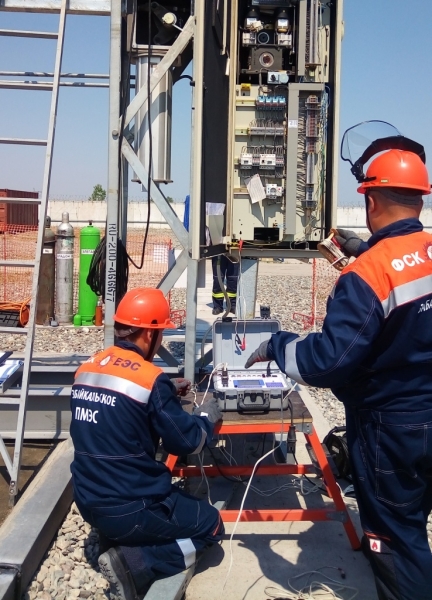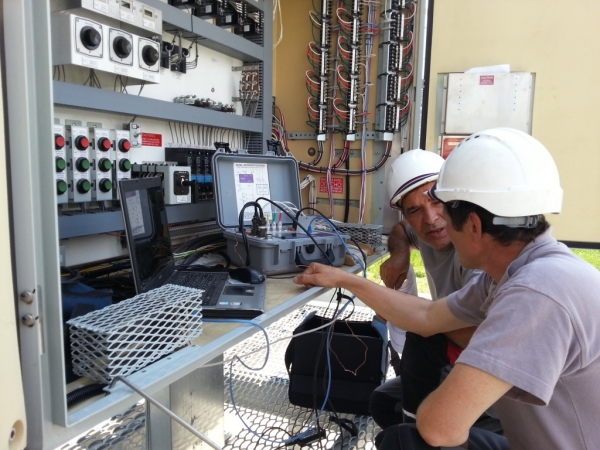What will "digital energy" choose: automation or portable diagnostics?
It has long been an open secret that the energy industry vitally needs to be modernized based on intelligent systems in order to increase efficiency and reduce capital and operating costs. This is what the Digital Energy state project is aimed at. In addition, you cannot save much on transformers, power lines, and structures — according to the laws of physics, the transmitted power requires the appropriate hardware, and the relative speed of transients associated with short circuits, closing and opening, swings, and stability violations requires the mandatory use of special devices. According to the "Digital Energy" project, they must be automatic and fast, and most importantly, ensure proper adjustment of transients in the system.
All this contributes to the broadest implementation of the automated process control system (APCS) for substations. It collects primary data on all technical parameters of objects, solves the problems of metrological support, performs procedures for direct control and remote control of equipment. Such a substation integrates the RPA subsystem, emergency automation, automated information and measurement system for commercial electricity metering, emergency event recorders, power equipment monitoring and diagnostics system, cable fault location system, systems for collecting and transmitting operational and non-operational process information, power quality control systems, engineering and auxiliary systems, and so on.
Of course, the functional tasks of APCS are very large-scale, but can everything be controlled, for example, by automatic systems for monitoring and diagnostics of power equipment?
We offer to consider the features of diagnostics using automatic monitoring systems (transducers) in real operating conditions and using specialized portable devices produced by SKB (Special Design Bureau) of Electric Instrument Engineering LLC (SKB EP), which require disconnection of voltage coming to the measured object, by the example of a high-voltage circuit breaker. A high-voltage (HV) circuit breaker is one of the most important types of electrical equipment in the energy system, so it is very important to properly monitor and diagnose its condition for timely detection of upcoming defects and malfunctions.
SKB EP has been developing and manufacturing portable diagnostic equipment for monitoring the technical condition of high-voltage circuit breakers and transformers for more than 28 years. The range of equipment produced today for the diagnosis of HV circuit breakers is well known in the I&C market and consists of five instruments: PKV/M7, PKV/U3.1, PKV/U3.0 and PKV/M17, which allows to measure travel parameters, as well as speed and time characteristics, recording charts of the cross-arm movement. In addition, due to the use of advanced technologies, our instruments can be used for circuit breakers made in the Soviet Union, Russia, and foreign countries, regardless of their type and voltage class.
The comparison will be based on the features of diagnostics of certain parameters of HV circuit breakers that can be measured in real-world operating conditions with those that require mandatory monitoring, but are only available when the object is not energized:
- Parameters related to the control of the travel and speed of the main contacts are available to both monitoring systems and specialized instruments of the PKV group, but there are some specifics. Determining speed of the main contacts when breaking the arc occurring under operating voltage can provide information about the state of the nozzle in the arc extinguish chamber, and diagnostics of the de-energized HV circuit breaker can measure press-in and travel parameters.
- Parameters associated with the control of switching time of the main contacts, namely: HV circuit breaker closing time, time difference between closing/opening of the main contacts, chatter, etc. are mandatory characteristics of HV circuit breakers that must be checked as specified in GOST R 52565-2006.
If the control is carried out in real operating conditions of the object under operating voltage, errors in determining these parameters appear. For example, the moment of opening the main contacts is determined by registering the time of disappearance of electric current, which presents a certain problem — when contacts are opened, electric current in the circuit is not interrupted, but continues to "flow" due to the arc formed until it crosses zero. Therefore, in a three-phase system, the moment of zero crossing in different phases occurs at different times, and even if there is a simultaneous opening of the contacts, current in different phases will disappear at different times. In addition, the accuracy of determining the moment of opening in real operation conditions is also affected by the fact that the arc duration depends on some factors (time constant of the opened circuit, for SF6 HV breakers — pressure/density of the SF6 gas and presence of impurities in it, current to break, etc.).
Thus, it is desirable to measure time parameters with a rated error only on a de-energized HV circuit breaker using specialized PKV instruments.
- Verification of the HV circuit breaker operation in the automatic reclosure mode, control of the duration of the closed position in an CO cycle, diagnosis of the correct operation of the overcurrent release device, etc. Despite the fact that there is a certain probability that these protections will never work on a particular HV circuit breaker, the staff must have full confidence in their serviceable condition. Most likely no one will artificially create conditions for checking the correct operation of the corresponding protections at an object that is under operating voltage, so their diagnosis is possible only on a de-energized HV circuit breaker.
- Monitoring of arc wear of the main contacts. One of the methods for assessing the wear of the arc extinguish contact of an HV circuit breaker that is no longer under high voltage is the dynamic measurement of the contact resistance. But in addition to the wear of the arc extinguish contact, other elements of the arc extinguish chamber wear due to the arc impact, for example, the nozzle of the arc extinguish chamber in an SF6 breaker. In this situation, the indicators associated with the broken current are used as an aggregated parameter of chamber wear. In this case, the procedure for determining the dependence of the wear on the broken current, as well as total wear, are individual for each type of HV circuit breaker and, according to GOST 52565-2006, must be specified in the operating manual for the object. Of course, the measurement of the broken current and automatic calculation of wear is available in automation devices (monitoring systems), as well as when calculating manually, for example, according to the switching log.
- Control of the electrical resistance of the main contacts. Increase in the contact resistance of the main contacts of an HV circuit breaker leads to their heating, which can be detected using, for example, stationary thermal imagers. At the same time, at the minimum amperage, the heating will be minimal, and the increased contact resistance may not be detected by the thermal imager. But the period of increasing power consumption, which leads to an increase in amperage, may occur at the moment when there are no backup facilities, therefore, it will not be possible to disconnect equipment for repair.
Therefore, the technical condition monitoring should be performed in advance, before the onset of a period of increased energy consumption, using such devices as microohmmeters. SKB EP adopts an integrated approach to diagnostics of HV circuit breakers, and in addition to PKV instruments, offers a range of MIKO microohmmeters that features high test current (up to 1000 A), extended measurement range and, of course, excellent functionality.
This list can be continued, but it can be absolutely certain that automatic monitoring and diagnostics systems (transducers) undoubtedly carry out measurements and record technical data of a high-voltage object. But this is actual data of something that is happening now, and planned diagnostics using portable PKV instruments allows checking the object's mechanisms in advance and preventing emergencies.
Moreover, PKV instruments allow you to monitor and evaluate the technical condition of the many HV circuit breaker components, such as the drive, the mechanism for transmitting motion from the drive to the movable contacts, damping devices, the contact system, drive power circuits, and control circuits. They can measure all rated characteristics: time, speed, travel, current of electromagnets, voltage, resistance of various rheostat sensors, high currents of solenoids in oil, vacuum, SF6 and air circuit breakers. Of course, they allow specialists to recognize faults at an early stage of development based on data obtained by displaying graphical processes ("method of early detection of defects in the mechanisms of HV circuit breakers").
The obtained measurement results can be processed on a PC using special software from the manufacturer, providing full digitization of user data. The ability to compare the recorded graphic processes (speed depending on time, speed depending on travel, travel depending on time) for various time period allows you to visually control the mechanisms of the equipment dynamically during operation.
And most importantly, the PKV equipment fully meets the requirements of Digital Energy, such as automation (accurate, complete and "independent" measurements of all rated parameters), performance (a comprehensive approach to controlled parameters reduces the duration of monitoring) and proper adjustment of objects (fault transmission and analysis, storage and comparison of data), which are responsible for transients in the energy system.
Instruments of this group have been on the market for several years, and their operation has been repeatedly accompanied by positive feedback from such companies as FGC UES PJSC, Rosseti PJSC, ROSATOM State Corporation, Oboronenergo OJSC, ZETO2 LLC, Elektroapparat OJSC IBC, Vostoknefteprovod LLC, Russian Railways OJSC, Hydroelectromontazh OJSC, UETM JSC and many others.
If you are interested in the PKV instruments, and you want to learn more, please contact our managers by phone +7 (812) 500-25-48 or by e-mail skb@skbep.com.

 Русский
Русский
 Français
Français
 Chinese
Chinese

